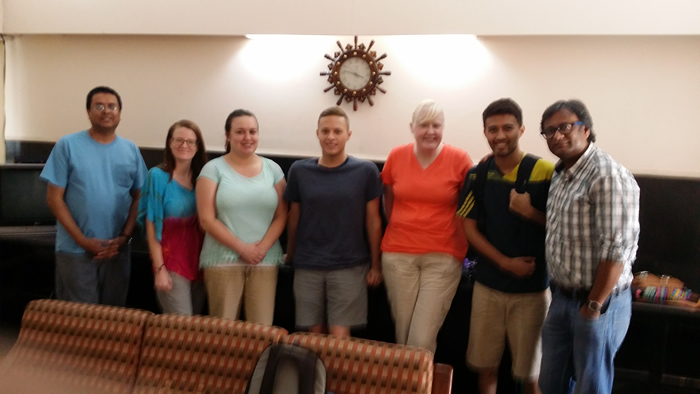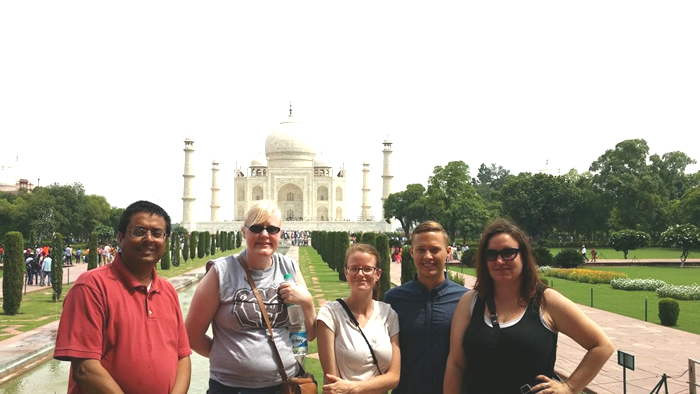The program attempted to expose students to the diversity that India constitutes in terms of the world¹s richest and poorest sharing the same space and the most vibrant democratic practices co-existing with feudal, casteist, and religious ones. At Missouri State University we emphasize on public affairs mission which broadly translates into articulation of these learned cultural values into capabilities to provide ethical leadership, a recognition and respect for multiplicity in society and building knowledge and experience to engage with a global community. To that end, the program provided nuanced opportunities for understanding the interacting dynamics of culture, gender, race, and class; biophysical factors, such as climate, population and natural resources; and economic and political processes all of which have led to the present day changing social inequalities in India.
The program included visits to environmental hotspots in the Himalayas; guided tours in places of historical interests; attendance of lectures and first hand engagements with experts and local folks; visits to places of religious interests, heritage sites, and social hangouts. They had ample time to explore neighborhoods and commercial places shop and visit to appreciate what it was like to be on their own in another place and in a different cultural situation.
While in New Delhi the second most populous city of the world students gained a firsthand appreciation of what an ever growing population does to the process of agglomeration, what challenges population boom can have on a mega city¹s infrastructure in an emerging economy like India and the opportunity it presents to the rest of the world. Travels in Leh and surrounding region in the state of Jammu and Kashmir and in the Himalayan landscape gave them a much better understanding of the hardships of living in a remote area and its consequences on one¹s quality of life. Even though the four places they visited were all within the northern region of India, there was tremendous diversity within this region between the mountainous terrain of the Himalayas, the deserts of Rajasthan and the plain area of the Ganga-Yamuna doab in which Delhi is located.
Visits to monasteries, mosques, temples and gurdwaras (Sikh temple) exposed them to the reality that this country with a population of 1.2 billion respects diversity in religion.
They were unanimous in their understanding that India was large, larger than what they were used to in terms of population, that it had tremendous diversity with many distinct pursuits, vastly different convictions, widely divergent customs and a feast of viewpoints. Some of the high point of this program was not the nuanced learning but the experiences they gained through visits to places such as Hemis Monastery located in Hemis, Ladakh and founded in 1672, the third highest motorable road Chang La a high mountain pass in Ladakh (17,590 ft above sea level), the Pangong Lake situated at a height of 14,270 ft above sea level on the border of India and Tibet and the mind boggling experience of river rafting in the mighty Zanskar river, a north flowing tributary of the Indus river at a height of 11,500 ft above sea level. The combined impact of all the above was profound and stimulating.
From the moment students exchanged their US dollar for Indian Rupee they realized that their money could buy more in India. A revelation which certainly brought smiles on their faces. The program director challenged them to consider living on a dollar a day which none could accept.
Sites Visited:
Agra
- Taj Mahal
Jaipur:
- Amber Fort
- Chokhi Dhani Resort
- City Palace and Jantar Mantar
- Johri Bazaar
- Nahargarh Fort
- Rajasthani Textile Export House
Leh and Ladakh region:
- Chang La
- Confluence of the Indus and Zanskar River
- Hall of Fame
- Hemis Monastery
- Leh Bazaar
- Pangong Lake
- Shey Palace and Sanchi Stupa
- Thiksey Monastery
New Delhi:
- Amity University
- Bengali Market and India International Center
- Chhattarpur Temples
- Dilli Hatt (Crafts Market)
- Gurdwara Bangla Sahib (Sikh Temple)
- Hauz Khas Village complex
- Hindustan Times
- India Gate
- India Habitat Centre
- Jama Masjid and Connaught Place
- Khan Market
- Lotus Temple
- Majnu-ka-Tilla (Tibetan Neighborhood)
- National Institute of Urban Affairs
- Parliament House
- Presidents House
- Qutub Minar
- Red Fort
- School of Planning and Architecture
- University of Delhi
- Yamuna River Front

The program definitely raised the cultural awareness and sensitivity of the students.
Participants:
- Amber Hall (Graduate student) an Arkansas native currently a student at Missouri State University-Springfield
- Cathy Walters (Former graduate student) from West Plains and an alumni of both West Plains and Springfield campus
- Andrew Behrens (Undergraduate student) from St. Louis and currently a student at Missouri State University-Springfield
- Caitlin Hunt (Undergraduate student) from St. Louis and currently a student at Missouri State University-Springfield
The strength of the program was the program director¹s intimate understanding of India’s culture, and the challenges that might have been there. In my understanding the program was a success.

